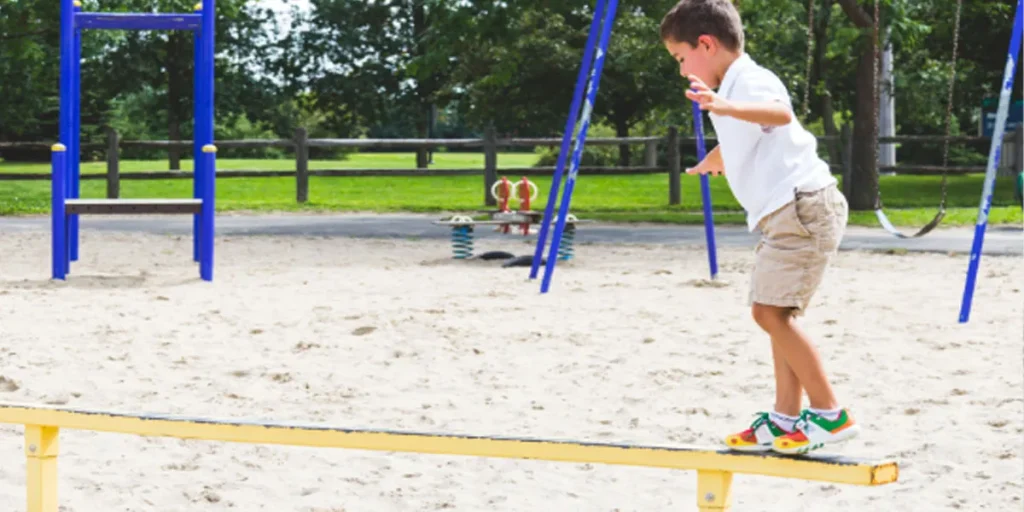Balance beams used in gymnastics are typically 10 centimeters (4 inches) wide. The regulation width supports gymnasts during intricate maneuvers and routines.
Balance beams are a quintessential piece of gymnastic equipment, demanding precision and skill from athletes.
These beams not only challenge a gymnast’s balance but also their concentration and grace under pressure.
Competitors perform a variety of skills on the beam, including jumps, turns, and acrobatic elements, which all require a strong sense of stability and body control.
The width of the beam is standardized to ensure consistency in training and competition worldwide, enabling gymnasts to hone their skills on a surface that allows for the complexity of modern gymnastic routines while maintaining safety standards.
The balance beam’s dimensions are critical for the progression and fairness of the sport, making it a fundamental aspect of gymnastics competitions at all levels.

Evolution Of Balance Beams
Balance beams play a critical role in gymnastics. They started very simple. Today, they showcase advanced design. This evolution has changed gymnastics. Let’s explore this fascinating journey.
From Logs To Modern Beams
Early balance beams were just logs. Ancient Greeks used them for agility. Over time, these logs transformed.
The modern balance beam came into existence. It is now a standard apparatus in gymnastics.
- Polished logs: were the first step in evolution.
- Hardwood beams: came next, providing more stability.
- Padded beams: the current beams are padded for safety.
Material Advancements
Material advancements have been crucial. They allowed for better performance and safety. Today’s beams use top materials. Here’s a brief look at this transformation:
| Year | Material | Advancement |
|---|---|---|
| Early years | Wood | For balance and agility |
| Mid 20th century | Metal, synthetic | More durability and safety |
| Today | Foam, suede | Comfort and non-slip surface |
Each material brought a new advantage. This kept athletes safe. It also let them perform complex routines. The balance beams today are a testament to this evolution.
Standard Dimensions Across Competitions
Welcome to the exciting world of gymnastics, where precision and skill beautifully come together.
A critical piece of equipment in this intricate dance of agility is the balance beam. Athletes across the globe compete on uniform equipment to ensure fairness.
International Federation Specifications
The International Gymnastics Federation (FIG) sets the standard for balance beam dimensions. All official competitions must follow these specifications:
- Length: Beams are 5 meters (16 feet, 5 inches) long.
- Width: The top where gymnasts perform is 10 centimeters (4 inches) wide.
- Height: Beams stand 125 centimeters (4 feet, 1 inch) off the ground.
This consistency ensures athletes compete on an even playing field, no matter the global location.
Olympic Regulation Sizes
The Olympic Games follow the FIG’s lead, with balance beams adhering to strict size regulations:
| Dimension | Size |
|---|---|
| Length | 5 meters (16 feet, 5 inches) |
| Width | 10 centimeters (4 inches) |
| Height | 125 centimeters (4 feet, 1 inch) |
Athletes trust these measurements for preparing and competing at their best. Gyms worldwide mimic these dimensions, so gymnasts train on the same type of equipment they will face on the big stage.
Impact Of Beam Width On Performance

The width of a balance beam can greatly affect a gymnast’s performance. The standard balance beam is just 4 inches wide, providing a narrow platform for a variety of skills.
This sleek dimension challenges gymnasts to master balance and precision, directly affecting their difficulty levels and scoring potential.
Balance And Precision
On the balance beam, every millimeter matters. Gymnasts must align their feet perfectly to maintain balance.
A wider beam may offer a slight edge for beginners, but as the levels advance, the standard 4-inch width is the mandate. This narrow path calls for absolute control and accuracy.
- Focus: Concentration is key as athletes navigate turns and flips.
- Coordination: Body alignment must be precise to avoid stumbles.
- Stability: Core strength ensures steadiness through routines.
Difficulty Levels And Scoring
The beam’s width influences the routine’s difficulty. High-level skills demand a narrow base, making the 4-inch beam perfect for competitive gymnasts.
Judges score based on routine complexity and athlete grace on this slim line. A flawless performance brings higher marks.
| Level | Routine Requirements | Expected Beam Width |
|---|---|---|
| Beginner | Basic skills, lower difficulty | Practice beams may be wider |
| Intermediate | Increased difficulty, more precision | Up to standard 4 inches |
| Advanced | High difficulty, ultimate precision | Standard 4 inches |
Training Routines For Narrow Beams
Training routines for narrow beams are crucial for gymnasts. A standard balance beam measures just 4 inches wide. This requires immense focus and precision.
Developing a training regimen for such narrow apparatus is essential. Let’s explore how to enhance technique, ensure safety, and prevent falls.
Technique Development
Mastering the balance beam starts with building a strong technique. Simple exercises like walking forward and backward help in gaining confidence.
- Practice jumps without arm movement to improve stability.
- Use lines on the floor before progressing to the high beam.
- Focus on foot placement to reduce wobbles during routines.
Safety Measures And Fall Prevention
Safety is paramount when training on narrow beams. Use mats and spotting to prevent injury.
- Always have a coach nearby during practice sessions.
- Apply grip tape to the beam for additional traction.
- Learn proper fall techniques to minimize injuries.
Choosing The Right Beam For Practice
Choosing the perfect balance beam is essential for both budding gymnasts and seasoned pros.
Specific beams suit different skill levels and environments. Knowing the options ensures optimal and safe practice.
Home Vs. Professional Gym Equipment
Home balance beams offer great flexibility for practice. Typically, these beams are softer and shorter than professional ones. They often rest directly on the floor, which enhances safety for learners.
Professional gym balance beams, on the other hand, are standardized for competition. They are longer, often up to 16 feet, and sit on sturdy legs at a regulated height.
Both types come in the official width of 4 inches, but choosing the right one depends on the gymnast’s level and space available.
Adjustable And Folding Beam Options
Exploring adjustable and folding balance beams can be game-changers for practice routines. Adjustable beams are perfect for growing athletes.
They can be raised or lowered, simulating a professional beam’s height. Lightweight and easy to store, folding beams cater to small spaces.
They unfold for practice and tuck away neatly after training. Here are some key features:
- Adjustable Height: Adapt to the gymnast’s comfort and skill level.
- Convenience: Quick setup and breakdown boost training efficiency.
- Space-Saving: Ideal for small home gyms or multifunctional rooms.
Choosing a beam with the right features enhances practice, confidence, and progress.
Maintaining And Caring For Balance Beams

The beauty and grace of gymnastics are often symbolized by the iconic balance beam. A core apparatus in any gymnast’s training regime, but the beam demands respect and care.
Maintaining and caring for balance beams ensure safety and longevity. Let’s explore how to keep these beams in perfect condition.
Routine Inspections
Regular checks are crucial for a well-maintained balance beam. These inspections should involve a close look at every part. A well-crafted checklist includes:
- Surface integrity: no cracks or wear.
- Screws and bolts: tight and corrosion-free.
- Support structure: steady with no wobble.
- Pads and ends: secure and undamaged.
Make these inspections part of the daily opening routine. This will help catch issues early before they pose risks.
Cleaning And Damage Repair
Keeping balance beams clean promotes a safe practice environment. Dirt and grime impact grip and performance. Here’s how to clean:
- Wipe down daily with a damp cloth.
- Use a mild cleaner approved for foam and vinyl.
- Avoid harsh chemicals that degrade materials.
For damage repair, act swiftly. Small nicks or cuts can turn into large tears. Immediate repair can prevent further damage.
Use a repair kit designed for balance beam surfaces. Patch up small areas and consult professionals for major fixes.
FAQs About the Width of Balance Beams
How Do You Make A Balance Beam At Home?
Select a sturdy, straight beam, about 4 inches wide for your balance base. Cover it with carpet or rubber for grip.
Place the beam on the ground or elevate using cinder blocks for stability. Ensure the setup is secure before practicing.
Are Balance Beams Made Of Wood?
Balance beams in gymnastics are traditionally made of wood, often with a leather or suede cover for traction. Modern beams may incorporate synthetic materials for durability.
Do Male Gymnasts Do Balance Beam?
No, male gymnasts do not perform on the balance beam in competitive artistic gymnastics; this event is exclusive to female gymnasts.
What Is Standard Balance Beam Size?
A standard balance beam in gymnastics measures 16 feet long (4. 88 meters), 4 inches wide (10 centimeters), and stands approximately 4 feet (1. 2 meters) high.
Conclusion
Exploring the width of balance beams has revealed their standard 10-centimeter measure.
This knowledge enhances both novice and elite gymnasts’ performance. Embracing the dimensions ensures safety and confidence during routines.
Remember, mastering a beam’s width paves the way to gymnastic prowess.
Strive and excel on this slender stage of agility.
Resources:
https://www.ncbi.nlm.nih.gov/pmc/articles/PMC8419348/
https://www.britannica.com/sports/balance-beam
